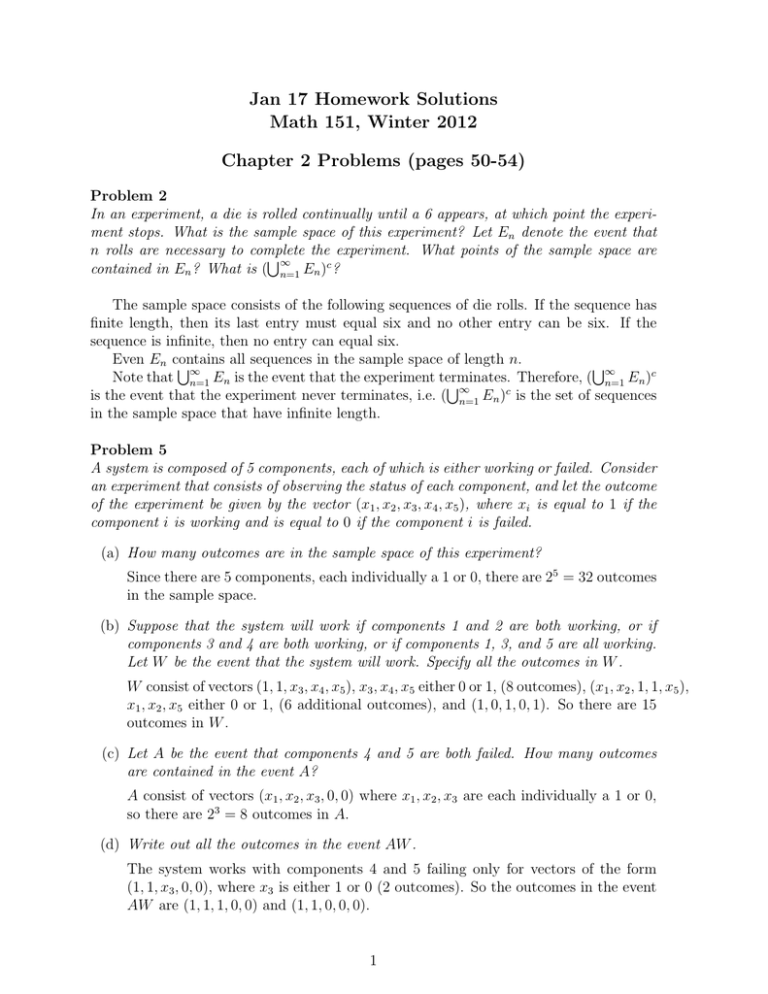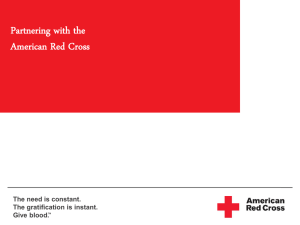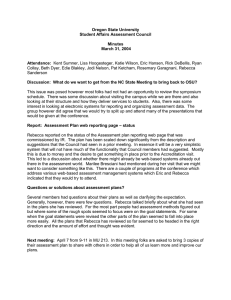Jan 17 Homework Solutions Math 151, Winter 2012
advertisement

Jan 17 Homework Solutions Math 151, Winter 2012 Chapter 2 Problems (pages 50-54) Problem 2 In an experiment, a die is rolled continually until a 6 appears, at which point the experiment stops. What is the sample space of this experiment? Let En denote the event that n rolls are necessary to complete S∞ thec experiment. What points of the sample space are contained in En ? What is ( n=1 En ) ? The sample space consists of the following sequences of die rolls. If the sequence has finite length, then its last entry must equal six and no other entry can be six. If the sequence is infinite, then no entry can equal six. Even En contains all sequences in the sample space of length n. S∞ S∞ c Therefore, ( Note that n=1 En is the event that the experiment terminates. n=1 En ) S∞ c is the event that the experiment never terminates, i.e. ( n=1 En ) is the set of sequences in the sample space that have infinite length. Problem 5 A system is composed of 5 components, each of which is either working or failed. Consider an experiment that consists of observing the status of each component, and let the outcome of the experiment be given by the vector (x1 , x2 , x3 , x4 , x5 ), where xi is equal to 1 if the component i is working and is equal to 0 if the component i is failed. (a) How many outcomes are in the sample space of this experiment? Since there are 5 components, each individually a 1 or 0, there are 25 = 32 outcomes in the sample space. (b) Suppose that the system will work if components 1 and 2 are both working, or if components 3 and 4 are both working, or if components 1, 3, and 5 are all working. Let W be the event that the system will work. Specify all the outcomes in W . W consist of vectors (1, 1, x3 , x4 , x5 ), x3 , x4 , x5 either 0 or 1, (8 outcomes), (x1 , x2 , 1, 1, x5 ), x1 , x2 , x5 either 0 or 1, (6 additional outcomes), and (1, 0, 1, 0, 1). So there are 15 outcomes in W . (c) Let A be the event that components 4 and 5 are both failed. How many outcomes are contained in the event A? A consist of vectors (x1 , x2 , x3 , 0, 0) where x1 , x2 , x3 are each individually a 1 or 0, so there are 23 = 8 outcomes in A. (d) Write out all the outcomes in the event AW . The system works with components 4 and 5 failing only for vectors of the form (1, 1, x3 , 0, 0), where x3 is either 1 or 0 (2 outcomes). So the outcomes in the event AW are (1, 1, 1, 0, 0) and (1, 1, 0, 0, 0). 1 Problem 8 Suppose that A and B are mutually exclusive events for which P (A) = .3 and P (B) = .5. What is the probability that (a) either A or B occurs? Since A and B are mutually exclusive, P (A ∪ B) = P (A) + P (B) = .3 + .5 = .8. (b) A occurs but B does not? Since A and B are mutually exclusive, P (AB c ) = P (A) = .3. (c) both A and B occur? Since A and B are mutually exclusive, A and B cannot both occur, so P (AB) = 0. Problem 12 An elementary school is offering 3 language classes: one in Spanish, one in French, and one in German. These classes are open to any of the 100 students in the school. There are 28 students in the Spanish class, 26 in the French class, and 16 in the German class. There are 12 students that are in both Spanish and French, 4 that are in both Spanish and German, and 6 that are in both French and German. In addition, there are 2 students taking all three classes. (a) If a student is chosen randomly, what is the probability that he or she is not in any of the language classes? Let S, F , and G denote the events of taking Spanish, French, and German, respectively. By the inclusion-exclusion identity, Proposition 4.4, we have P (S ∪ F ∪ G) = P (S) + P (F ) + P (G) − P (SF ) − P (SG) − P (F G) + P (SF G) 26 16 12 4 6 2 28 + + − − − + = 100 100 100 100 100 100 100 50 = . 100 Thus the probability of not taking any of the classes is P ((S ∪ F ∪ G)c ) = 1 − P (S ∪ F ∪ G) = 1 − 50 50 = . 100 100 (b) If a student is chosen randomly, what is the probability that he or she is taking exactly one language class? We present two different solutions to this problem. First solution: Since there are 2 students taking all 3 classes, this means that there are • 12 − 2 = 10 students in Spanish and French but not German, • 4 − 2 = 2 students in both Spanish and German but not French, and • 6 − 2 = 4 students in both French and German but not Spanish. 2 Hence we have 10 + 2 + 4 = 16 students taking exactly two language classes, and 2 students taking exactly 3 language classes. We essentially computed in part (a) that there are 50 students taking at least one language class. So the number of students taking exactly one language class is 50 − 16 − 2 = 32. Hence the probability that 32 . a random student is taking exactly one language class is 100 Second solution: In the sum #S + #F + #G − 2#SF − 2#SG − 2#F G + 3#SF G, students taking only one language class are counted once, students taking two language classes are counted 1 · 2 − 2 = 0 times, and students taking all three language classes are counted 1 · 3 − 2 · 3 + 3 = 0 times. Thus the probability of taking exactly one language class is = = P (S) + P (F ) + P (G) − 2P (SF ) − 2P (SG) − 2P (F G) + 3P (SF G) 26 16 12 4 6 2 28 + + −2· −2· −2· +3· 100 100 100 100 100 100 100 32 . 100 (c) If 2 students are chosen randomly, what is the probability that at least 1 is taking a language class? We essentially computed in part (a) that there are 50 students taking at least one language class. Let Ei , i = 1, 2, denote the event that the i-th student is taking a language class. By inclusion-exclusion, Proposition 4.4, we have P (E1 ∪ E2 ) = P (E1 ) + P (E2 ) − P (E1 E2 ) = Problem 15 If it is assumed that all dealt 52 5 50 50 · 49 149 50 + − = . 100 100 100 · 99 198 poker hands are equally likely, what is the probability of being (a) a flush? (A hand is said to be a flush if all 5 cards are of the same suit.) There are 4 choices for the suit and 13 choices for the cards in that suit. Hence 5 13 the number of different flush hands is 4 · 5 , and the probability of a flush is 4 · 13 5 = .001981. 52 5 (b) one pair? (This occurs when the cards have denominations a, a, b, c, d where a, b, c and d are all distinct.) There are 13 choices for the value of a, 42 choices for the suits of a, 12 choices 3 for the values of b, c, and d, 4 choices for the suit of b, 4 choices for the suit of c, and 4 choices for the suit of d. Hence the probability of a one pair is 13 · 42 · 12 ·4·4·4 3 = .422569. 52 5 3 (c) two pairs? (This occurs when the cards have denominations a, a, b, b, c where a, b, and c are all distinct.) 4 4 There are 13 choices for the values of a and b, choices for the suits of a, 2 2 2 choices for the suits of b, and 44 choices for c from the remaining cards. Thus the probability of a two pair is 4 4 13 · 2 · 2 · 44 2 = .047539. 52 5 (d) three of a kind? (This occurs when the cards have denominations a, a, a, b, c where a, b, and c are all distinct.) There are 13 choices for the value of a, 43 choices for the suits of a, 12 choices 2 for the values of b and c, 4 choices for the suit of b, and 4 choices for the suit of c. Thus the probability of a three of a kind is 13 · 43 · 12 ·4·4 2 = .021128. 52 5 (e) four of a kind? (This occurs when the cards have denominations a, a, a, a, b.) There are 13 choices for the value of a, 44 choices for the suits of a, and 48 choices for b from the remaining cards. Thus the probability of a four of a kind is 13 · 44 · 48 = .00024. 52 5 Problem 18 Two cards are randomly selected from an ordinary playing deck. What is the probability that they form a blackjack? That is, what is the probability that one of the cards is an ace and the other one is either a ten, a jack, a queen, or a king? There are 4 possible aces and 4 · 4 = 16 tens, jacks, queens, and kings, so there are ways to choose two cards. Therefore 4 · 16 = 64 ways to select black jack. There are 52 2 the probability of black jack is 64 = .048265. (522) Problem 30 The chess clubs of two schools consist of, respectively, 8 and 9 players. Four members from each club are randomly chosen to participate in a contest between two schools. The chosen players from one team are then randomly paired with those from the other team, and each pairing plays a game of chess. Suppose that Rebecca and her sister Elise are on the chess clubs at different schools. What is the probability that 4 (a) Rebecca and Elise will be paired? The probability that Rebecca will be chosen to represent her school is 84 . The probability that Elise will be chosen to represent her school is 49 . Assuming that both Rebecca and Elise are chosen, the probability that they will be paired is 14 . Therefore, the probability that Rebecca and Elise will be paired is 1 4 4 1 · · = . 8 9 4 18 (b) Rebecca and Elise will be chosen to represent their schools but will not play each other? The probability that Rebecca will be chosen to represent her school is 84 . The probability that Elise will be chosen to represent her school is 49 . Assuming that both Rebecca and Elise are chosen, the probability that they will not be paired is 3 . Therefore, the probability that Rebecca and Elise will be chosen to represent 4 their schools but will not play each other is 4 4 3 1 · · = . 8 9 4 6 (c) either Rebecca or Elise will be chosen to represent her school? Let R be the event that Rebecca is chosen to represent her school and let E be the event that Elise is chosen to represent her school. We are interested in calculating P (R ∪ E). By the inclusion-exclusion identity, Proposition 4.4, we have P (R ∪ E) = P (R) + P (E) − P (RE) 4 4 4 4 = + − · 8 9 8 9 13 = . 18 Problem 32 A group of individuals containing b boys and g girls is lined up in random order; that is, each of the (b + g)! permutations is assumed to be equally likely. What is the probability that the person in the i-th position, 1 ≤ i ≤ b + g, is a girl? The number of ways to chose a girl for the i-th position is g and there are (b + g − 1)! ways to order the people in the remaining positions. Therefore the probability that the person in the i-th position is a girl is g · (b + g − 1)! g = . (b + g)! b+g An easier way of doing this problem is to note that all b + g people are equally likely to end up in the i-th position, and g of the people are girls. Hence the probability that 5 the person in the i-th position is a girl is g . b+g Problem 38 There are n socks, 3 or which are red, in a drawer. What is the value of n if, when 2 of the socks are chosen randomly, the probability that they are both red is 12 ? The probability of choosing two red socks is 2 6 3 · = . n n−1 n(n − 1) 6 Solving n(n−1) = 21 yields n2 − n = 12, or (n − 4)(n + 3) = 0. This implies that n = 4 since n must be positive. Hence there are 4 socks in the drawer. Problem 42 Two dice are thrown n times in succession. Compute the probability that double 6 appears at least once. How large need n be to make this probability at least 12 ? Note that the probability that a double 6 appears at least once is equal to one minus the probability that double 6 never appears. The probability that double 6 never appears 35 n in n die rolls is 36 . Hence the probability that a double 6 appears at least once is n 35 1− . 36 Consider the equation 1− 35 n 36 1 ≥ . 2 After rearranging, we get 35 n 1 ≤ . 2 36 Taking the logarithm of both sides, we get 35 1 n log ≤ log . 36 2 We divide by log 35 , which is negative, to get 36 n ≥ log 1 2 / log 35 36 = 24.6051. So the probability of throwing at least one double 6 is at least 1 2 if n ≥ 25. Section 2 Theoretical Exercises (page 55) Problem 9 Suppose that an experiment is performed n times. For any event E of the sample space, let n(E) denote the number of times that event E occurs and define f (E) = n(E)/n. Show that f (·) satisfies Axioms 1, 2, and 3. 6 (1) Axiom 1: Since an event can occur in only a positive number of trials and in no more than n trials, we have 0 ≤ n(E) ≤ n. Dividing by n, we get so 0 ≤ n(E)/n = f (E) ≤ 1. Hence f (·) satisfies Axiom 1. (2) Axiom 2: Since the experiment has n outcomes, f (S) = n(S)/n = n/n = 1. Hence f (·) satisfies Axiom 2. (3) Axiom 3: Suppose E1 , E2 , E3 , ... is a sequence of mutually exclusive events. S Note that becuase the events E1 , E2 , E3 , ... are mutuallyP exclusive, the number n( ∞ i=1 Ei ) ∞ of times that the union occurs is equal to the sum i=1 n(Ei ) of the number of times that each event occurs. We have S ∞ [ n( ∞ i=1 Ei ) by definition of f f ( Ei ) = n i=1 P∞ n(Ei ) = i=1 because the events are mutually exclusive n ∞ X n(Ei ) = n i=1 = ∞ X f (Ei ) by definition of f i=1 Hence f (·) satisfies Axiom 3. Problem 15 An urn contains M white and N black balls. If a random sample of size r is chosen, what is the probability that it contains exactly k white balls? N There are Mk ways to choose k white balls and r−k ways to choose the remaining M N r − k black balls. Hence there are k · r−k samples of size r containing exactly k white balls. Overall, there are M +N samples of size r. Hence the probability that the urn r contains exactly k white balls is M N · k r−k . M +N r 7

